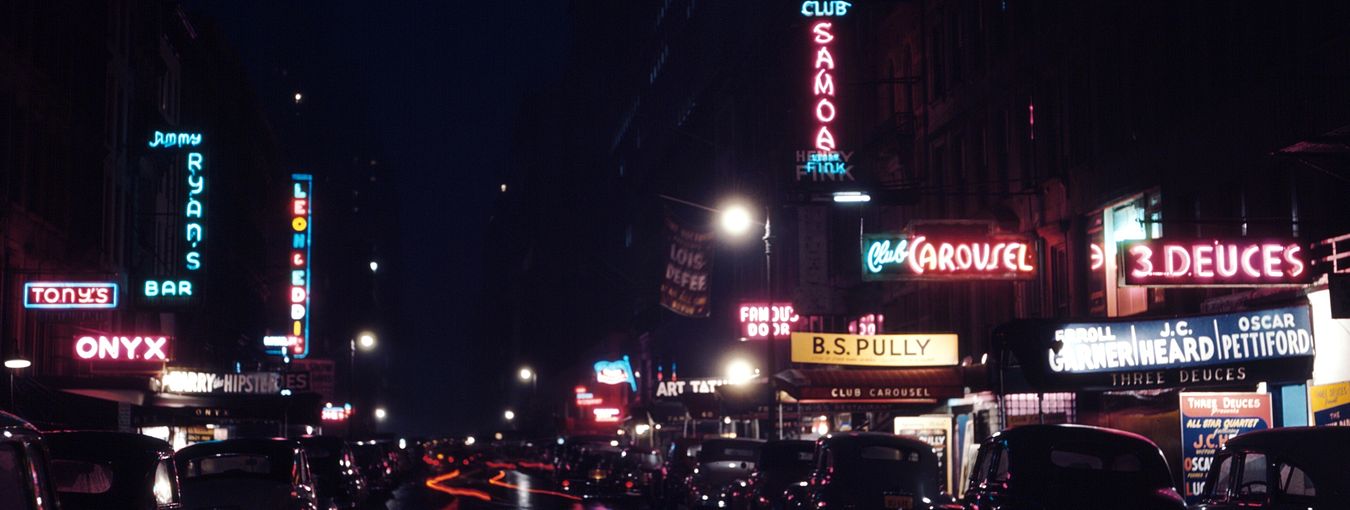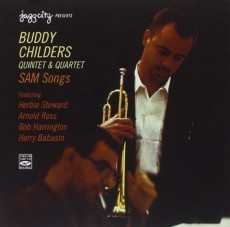
Daily Dose Of Jazz…
Buddy Childers was born Marion Childers in Belleville, Illinois on February 12, 1926. He came to fame in 1942 at the age of 16 when he took over the first trumpet chair in the Stan Kenton Orchestra. For years he worked with Kenton as well as performing with Tommy Dorsey, Woody Herman, Les Brown, Charlie Barnet, Dan Terry and other big bands.
He would go on to work with Gene Ammons, Elmer Bernstein, Maynard Ferguson, Clare Fischer, Milt Jackson, Carmen McRae, Oliver Nelson and Lalo Schifrin among others. No stranger to television programs and or films, Childers put together a big band that recorded for Candid Records in the 1980s and 1990s. He also recorded quintet and quartet sessions with Herbie Steward, Arnold Ross, Bob Harrington and Harry Babasin on the Jazz City label.
Trumpeter, composer and ensemble leader Buddy Childers passed away of cancer on May 24, 2007, at the age of 81.
More Posts: trumpet
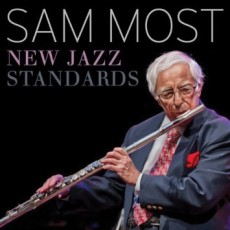
Daily Dose Of Jazz…
Samuel Most was born on December 16, 1930 in Atlantic City, New Jersey and learned to play the flute, saxophone and piano. He began his career in music at the age of 18 with the bands of Tommy Dorsey, Shep Fields, Boyd Raeburn and Don Redman. He also performed many times with his older brother Abe, a clarinetist.
His first recording was at age 23, a single called Undercurrent Blues and the following year he was awarded Down Beat magazine’s “Critic’s New Star Award”. Between 1953 and 1958 Sam led and recorded sessions for the Prestige, Debut, Vanguard and Bethlehem record labels. He also worked as a session player for Chris Connor, Paul Quinichette and Teddy Wilson and was a member of the Buddy Rich band from 1959 to 1961. He would go on to work as a sideman with Clare Fischer, Lalo Schifrin and Louie Bellson.
Most resurfaced in the late 1970s and recorded six albums on the Xanadu label, was given a gift of an expensively carved flute by Frank Sinatra who had used it for breath control, and in the late Eighties recorded four albums, including Solo Flute with producer Fernando Gelbard of Liquidjazz.com. He was the guest of and played for the King of Thailand three times and was the subject of Edmond Goff’s 2001 documentary film Sam Most, Jazz Flutist.
Flautist and tenor saxophonist Sam Most, who according to jazz historian Leonard Feather, was probably the first great jazz flutist, passed away on June 13, 2013 from cancer, at the age of 82.
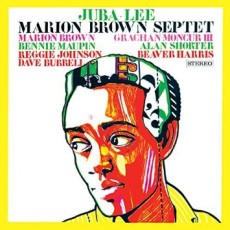
Daily Dose Of Jazz…
Marion Brown was born on September 8, 1931 in Atlanta, Georgia. He joined the Army in 1953 and three years later attended Clark College to study music. By 1960 he left Atlanta for pre-law at Howard University but after two years moved to New York City and befriended Amiri Baraka, Ornette Coleman, Archie Shepp, Sun Ra, Pharoah Sanders, Paul Bley, Clifford Thornton and Rashied Ali. During this early Sixties period he recorded several important albums such as Archie Shepp’s Fire Music and New Wave In Jazz, and most notably on John Coltrane’s Ascension.
1967 saw Brown in Paris, France where he developed an interest in architecture, impressionist art, African music and the music of Eric Satie. He became an American Fellow in Music Composition and Performance at the Cite International Des Artists in Paris, composed the soundtrack for Marcel Camus’ film Le Temps fou, a soundtrack featuring Steve McCall, Barre Phillips, Ambrose Jackson and Gunter Hall.
Returning to the US in 1970 he landed in New Haven, Connecticut taking a position as a resource teacher in a child study center in the city’s public school system for a year. He went on to be an assistant professor of music at Bowdoin College, and through the 70s joined the faculties of Brandeis University, Colby College, Amherst College and Wesleyan University, earning a Masters in ethnomusicology at the latter.
Throughout his many educational positions, Brown continued to compose and perform, lending his alto saxophone to the recording of Harold Budd’s The Pavilion of Dreams. He received grants from the National Endowment for the Arts, composing and publishing several pieces for solo piano. In 1981, he ventured into drawing and painting and his charcoal portrait of blues guitarist Blind Lemon Jefferson was included in a New York City Kenkeleba Gallery art show called Jus’ Jass, alongside Romare Bearden, Charles Searles and Joe Overstreet.
By the 2000s, avant-garde alto saxophonist Marion Brown had fallen ill due to a series of surgeries and a partial leg amputation. For a time he was in a New York nursing home but in 2005 he moved to an assisted living facility in Hollywood, Florida. He left a catalogue of twenty-five albums as a leader and several more as a sideman before he passed away on October 18, 2010 at age 79.
More Posts: saxophone

From Broadway To 52nd Street
As our final installment on the musicals and the songs that have gone on to become classics in the jazz catalogue, Broadway has entertained millions of audiences from around the world and has touched every human emotion and story one can imagine. It has captured our hearts and taken us on journeys to unexpected destinations both visceral and intuitive.
The Broadway musical played an integral role in the creation of the Great American Songbook as songs from the legendary composers and lyricists like Gershwin, Porter, KernRodgers, Hammerstein, Van Heusen, Hart, Webber, Rice, Loesser, Bricusse, Newley, Styne, Comden etc. have filled the pages of our imaginations
The “blockbuster” musicals were so successful that they ran over a thousand performances. A small aggregation of only 17 comprised of Oklahoma (2,212), Annie Get Your Gun (1,147), Kiss Me Kate (1,077), South Pacific (1,925), Guys & Dolls (1,200), The King And I (1,246), The Pajama Game (1,063), My Fair Lady (2,717), How To Succeed In Business (1,417), Funny Girl (1,348), Hello Dolly (2,844), Fiddler On The Roof (3,242), The Sound Of Music (1,443), Mame (1,508), Promises, Promises (1,281), Ain’t Misbehavin’ (1,604) and Evita (1,567).
To describe Broadway one would beg permission to borrow from Tevya in Fiddler On The Roof – “without tradition our lives would be as shaky as a fiddler on the roof!”
The lyrics and composition that were relegated to the amphitheaters of “The Great White Way” have received perpetual encores over the past century under the auspices of “The Street” and the songs continue to be honored by living legends, contemporaries and the “new breed” of jazz musicians and vocalists.
52nd Street, between Fifth and Seventh Avenues was known as “Swing Street” was equally attended by hundreds of thousands during its heyday between the 1930s and 1950s in just thirteen clubs. Equally blockbuster are the million selling albums of Miles Davis (Kind of Blue), Dave Brubeck (Time Out), John Coltrane (A Love Supreme, Blue Train), Herbie Hancock (Headhunters), Louis Armstrong (What A Wonderful World), Ella Fitzgerald (Best of the Songbooks).
To describe 52nd Street one would merely state that it was the epicenter of jazz in New York City and the connection between the musicians who played on Broadway and the legitimate clubs. It was the place where musicians who played for others earlier in the night, played for themselves on 52nd Street.
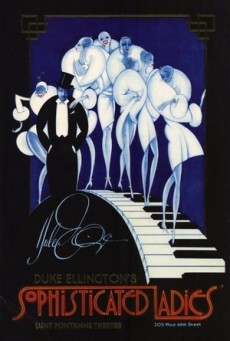
From Broadway To 52nd Street
Sophisticated Ladies had a preview run of 15 shows beginning February 16th prior to its official opening at the Lunt Fontanne Theatre on March 1, 1981 and ran for 767 performances. Duke Ellington composed the music for the revue with a cast that included Gregory Hines, Judith Jamison, Phyllis Hyman, Hinton Battle, Gregg Burge and Mercer Ellington. Hines’ older brother Maurice joined the cast later in the run.
The score includes classic jazz tunes “Mood Indigo,” “Take The “A” Train, I’m Beginning To See The Light, Hit Me With A Hot Note and See Me Bounce, It Don’t Mean A Thing (If It Ain’t Got That Swing), I Let A Song Go Out Of My Heart, Old Man Blues, In A Sentimental Mood, Sophisticated Lady, Don’t Get Around Much Anymore, Satin Doll and I Got It Bad And That Ain’t Good among numerous others.
Jazz History: In the 1980s the jazz community shrank dramatically and split. A mainly older audience retained an interest in traditional and straight-ahead jazz styles. Wynton Marsalis strove to create music within what he believed was the tradition, creating extensions of small and large forms initially pioneered by such artists as Louis Armstrong and Duke Ellington. In the early part of the decade, a commercial form of jazz fusion called pop fusion or smooth jazz became successful and garnered significant radio airplay.
Smooth jazz received frequent airplay with more straight-ahead jazz in “Quiet Storm” time slots (a format begun at Howard University’s WHUR by host Melvin Lindsay) at radio stations in urban markets across the United States. This helped to establish or bolster the careers of Grover Washington, Jr., Kenny G, Kirk Whalum, Boney James and David Sanborn and vocalists including Al Jarreau, Anita Baker, Chaka Khan and Sade.
In this same time period “Echoes of an Era” was released by the sextet comprised of Chaka Khan (vocal), Joe Henderson (saxophone), Freddie Hubbard (trumpet), Chick Corea (piano), Stanley Clarke (bass) and Lenny White (drums). The quintet released another “Echoes” enlisting the vocal talents of Nancy Wilson. The quintet would also release two albums titled “The Griffith Park Collection”.
Sponsored By
www.whatissuitetabu.com



